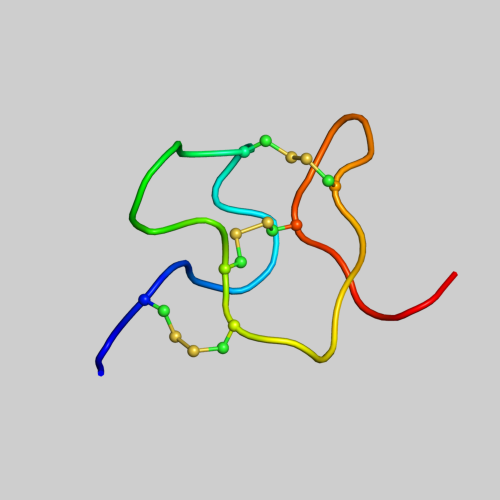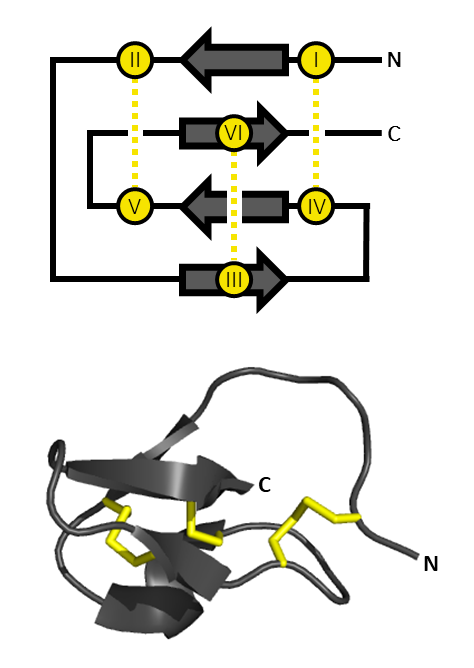|
Heteropodatoxin
Heteropodatoxins are peptide toxins from the venom of the giant crab spider ''Heteropoda venatoria'', which block Kv4.2 voltage-gated potassium channels. Sources Heteropodatoxins are purified from the venom of the giant crab spider, ''Heteropoda venatoria'' . Chemistry Heteropodatoxins contain an Inhibitor cystine knot, Inhibitor Cystine Knot (ICK) motif, which consist of a compact disulfide-bonded core, from which four loops emerge . There are three different heteropodatoxins : * heteropodatoxin-1, also known as Toxin AU3/KJ5 or HpTx1 * heteropodatoxin-2, also known as Toxin KJ6 or HpTx2 * heteropodatoxin-3, also known as Toxin AU5C/KJ7 or HpTx3 These three toxins are structurally similar peptides of 29-32 amino acids . They show sequence similarity to Hanatoxins, which can be isolated from the venom of the Chilean rose tarantula Grammostola rosea . Target Heteropodatoxins block A-type, transient voltage-gated potassium channels. All three toxins have been shown to bloc ... [...More Info...] [...Related Items...] OR: [Wikipedia] [Google] [Baidu] |
Peptide
Peptides (, ) are short chains of amino acids linked by peptide bonds. Long chains of amino acids are called proteins. Chains of fewer than twenty amino acids are called oligopeptides, and include dipeptides, tripeptides, and tetrapeptides. A polypeptide is a longer, continuous, unbranched peptide chain. Hence, peptides fall under the broad chemical classes of biological polymers and oligomers, alongside nucleic acids, oligosaccharides, polysaccharides, and others. A polypeptide that contains more than approximately 50 amino acids is known as a protein. Proteins consist of one or more polypeptides arranged in a biologically functional way, often bound to ligands such as coenzymes and cofactors, or to another protein or other macromolecule such as DNA or RNA, or to complex macromolecular assemblies. Amino acids that have been incorporated into peptides are termed residues. A water molecule is released during formation of each amide bond.. All peptides except cyclic pep ... [...More Info...] [...Related Items...] OR: [Wikipedia] [Google] [Baidu] |
Heteropoda Venatoria
''Heteropoda venatoria'' is a species of spider in the family Sparassidae, the huntsman spiders. It is native to the tropical regions of the world, and it is present in some subtropical areas as an introduced species. Its common names include giant crab spider, or cane spider.Edwards, G. BHuntsman Spider, ''Heteropoda venatoria'' (Linnaeus) (Arachnida: Araneae: Sparassidae).EENY-160. Entomology and Nematology. Florida Cooperative Extension Service. University of Florida IFAS. Published 2000, revised 2009. Description The adult has a flat, brown body 2 to 2.5 cm (0.8 to 1 inch) long, 7 to 10 cm (3 to 4 inches) wide, including the legs. The female may be slightly larger than the male, particularly in the abdomen, but the male has longer legs and larger tips on its pedipalps. The clypeus, the area just in front of the eyes, is cream or yellowish, and the carapace behind the eyes has a wide band which is usually tan in the female and cream in the male. The body is not ver ... [...More Info...] [...Related Items...] OR: [Wikipedia] [Google] [Baidu] |
Voltage-gated Potassium Channel
Voltage-gated potassium channels (VGKCs) are transmembrane channels specific for potassium and sensitive to voltage changes in the cell's membrane potential. During action potentials, they play a crucial role in returning the depolarized cell to a resting state. Classification Alpha subunits Alpha subunits form the actual conductance pore. Based on sequence homology of the hydrophobic transmembrane cores, the alpha subunits of voltage-gated potassium channels are grouped into 12 classes. These are labeled Kvα1-12. The following is a list of the 40 known human voltage-gated potassium channel alpha subunits grouped first according to function and then subgrouped according to the Kv sequence homology classification scheme: Delayed rectifier slowly inactivating or non-inactivating *Kvα1.x - Shaker-related: Kv1.1 (KCNA1), Kv1.2 (KCNA2), Kv1.3 (KCNA3), Kv1.5 (KCNA5), Kv1.6 (KCNA6), Kv1.7 ( KCNA7), Kv1.8 (KCNA10) *Kvα2.x - Shab-related: Kv2.1 (KCNB1), Kv2.2 (KCNB2) *Kvα3.x - ... [...More Info...] [...Related Items...] OR: [Wikipedia] [Google] [Baidu] |
Inhibitor Cystine Knot
An inhibitor cystine knot (aka ICK or Knottin) is a protein structural motif containing three disulfide bridges. Knottins are one of three folds in the cystine knot motif; the other closely related knots are the Growth Factor Cystine Knot (GFCK) and the Cyclic Cystine Knot (CCK; cyclotide). Types include a) cyclic mobius, b) cyclic bracelet, c) acyclic inhibitor knottins. Cystine knot motifs are found frequently in nature in a plethora of plants, animals, and fungi and serve diverse functions from appetite suppression to anti-fungal activity. Along with the sections of polypeptide between them, two disulfides form a loop through which the third disulfide bond (linking the 3rd and 6th cysteine in the sequence) passes, forming a knot. The motif is common in invertebrate toxins such as those from arachnids and molluscs. The motif is also found in some inhibitor proteins found in plants, but the plant and animal motifs are thought to be a product of convergent evolution. The ICK moti ... [...More Info...] [...Related Items...] OR: [Wikipedia] [Google] [Baidu] |
Toxins
A toxin is a naturally occurring organic poison produced by metabolic activities of living cells or organisms. Toxins occur especially as a protein or conjugated protein. The term toxin was first used by organic chemist Ludwig Brieger (1849–1919) and is derived from the word toxic. Toxins can be small molecules, peptides, or proteins that are capable of causing disease on contact with or absorption by body tissues interacting with biological macromolecules such as enzymes or cellular receptors. Toxins vary greatly in their toxicity, ranging from usually minor (such as a bee sting) to potentially fatal even at extremely low doses (such as botulinum toxin). Toxins are largely secondary metabolites, which are organic compounds that are not directly involved in an organism's growth, development, or reproduction, instead often aiding it in matters of defense. Terminology Toxins are often distinguished from other chemical agents strictly based on their biological origin. Les ... [...More Info...] [...Related Items...] OR: [Wikipedia] [Google] [Baidu] |
Chilean Rose Tarantula
The Chilean rose tarantula (''Grammostola rosea''), also known as the rose hair tarantula, the Chilean fire tarantula, or the Chilean red-haired tarantula (depending on the color morph), is probably the most common species of tarantula available in American and European pet stores today, due to the large number of wild-caught specimens exported cheaply from their native Chile into the pet trade. The species is also known from Bolivia and Argentina.Muller-Esnault, Susan, DVM. "Rose Hair Tarantulas or Chilean Rose Hair" (2008). http://www.critterology.com/rose_hair_tarantulas_or_chilean_rose_hair-192.html ''G. rosea'' is a common pet of tarantula hobbyists. Females have been known to live as long as 20 years, but due to the limited time they have been available on the market (and hence for extensive study), they may live considerably longer than 20 years. Considerable confusion exists between this species and ''Grammostola porteri'', with some arguing that many of the "''G.&nbs ... [...More Info...] [...Related Items...] OR: [Wikipedia] [Google] [Baidu] |
Gating (electrophysiology)
In electrophysiology, the term gating refers to the opening (activation) or closing (by deactivation or inactivation) of ion channels. This change in conformation is a response to changes in transmembrane voltage. When ion channels are in a 'closed' (non-conducting) state, they are impermeable to ions and do not conduct electrical current. When ion channels are in their open state, they conduct electrical current by allowing specific types of ions to pass through them, and thus, across the plasma membrane of the cell. Gating is the process by which an ion channel transitions between its open and closed states. A variety of cellular changes can trigger gating, depending on the ion channel, including changes in voltage across the cell membrane (voltage-gated ion channels), chemicals interacting with the ion channel (ligand-gated ion channels), changes in temperature, stretching or deformation of the cell membrane, addition of a phosphate group to the ion channel (phosphorylation), a ... [...More Info...] [...Related Items...] OR: [Wikipedia] [Google] [Baidu] |
Activation
Activation, in chemistry and biology, is the process whereby something is prepared or excited for a subsequent reaction. Chemistry In chemistry, "activation" refers to the reversible transition of a molecule into a nearly identical chemical or physical state, with the defining characteristic being that this resultant state exhibits an increased propensity to undergo a specified chemical reaction. Thus, activation is conceptually the opposite of protection, in which the resulting state exhibits a ''decreased'' propensity to undergo a certain reaction. The energy of activation specifies the amount of free energy the reactants must possess (in addition to their rest energy) in order to initiate their conversion into corresponding products—that is, in order to reach the transition state for the reaction. The energy needed for activation can be quite small, and often it is provided by the natural random thermal fluctuations of the molecules themselves (i.e. without any external ... [...More Info...] [...Related Items...] OR: [Wikipedia] [Google] [Baidu] |
Potassium Channel
Potassium channels are the most widely distributed type of ion channel found in virtually all organisms. They form potassium-selective pores that span cell membranes. Potassium channels are found in most cell types and control a wide variety of cell functions. Function Potassium channels function to conduct potassium ions down their electrochemical gradient, doing so both rapidly (up to the diffusion rate of K+ ions in bulk water) and selectively (excluding, most notably, sodium despite the sub-angstrom difference in ionic radius). Biologically, these channels act to set or reset the resting potential in many cells. In excitable cells, such as neurons, the delayed counterflow of potassium ions shapes the action potential. By contributing to the regulation of the cardiac action potential duration in cardiac muscle, malfunction of potassium channels may cause life-threatening arrhythmias. Potassium channels may also be involved in maintaining vascular tone. They also regulate ce ... [...More Info...] [...Related Items...] OR: [Wikipedia] [Google] [Baidu] |




